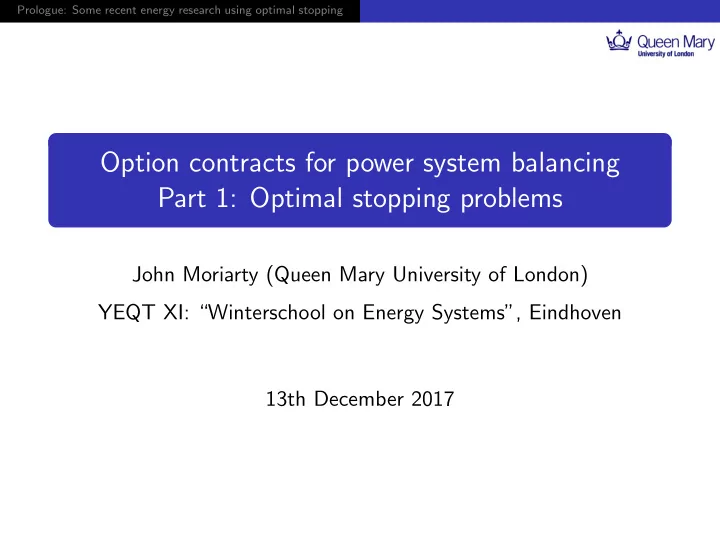

Prologue: Some recent energy research using optimal stopping Option contracts for power system balancing Part 1: Optimal stopping problems John Moriarty (Queen Mary University of London) YEQT XI: “Winterschool on Energy Systems”, Eindhoven 13th December 2017
Prologue: Some recent energy research using optimal stopping The 37% Rule At the British Psychological Society’s conference in April 1997 Dr Peter Todd, of the Max Planck Institute in Munich, spoke about the best (optimal) strategy for finding a partner, or finding a suitable new employee from a range of applicants Source: Plus magazine
Prologue: Some recent energy research using optimal stopping He quoted the following rule: The 37% rule Once you have seen 37% of the applicants, a coherent picture of the ideal employee is built up and the next person to fulfil these criteria should be given the job. This is an example of an optimal stopping problem : when to stop merely observing, and act. Figure: Another optimal stopping problem (source: Plus magazine )
Prologue: Some recent energy research using optimal stopping Suppose there is a pool of N candidates and you decide to observe at least M . That is, you Observe the first M − 1 candidates without acting, then Select the next candidate which is better then all of these M − 1. Example: Let N = 4 and number the candidates from 1 to 4 (4 is best, no ties). Figure: Left: Permutations when N = 4. Centre: For each M , permutations yielding best choice: Best M = 2. Right: The asymptotically optimal proportion for large N is 1 / e (source: Plus magazine )
Prologue: Some recent energy research using optimal stopping Optimal stopping has been the subject of wide study: First solved in discrete time: Wald (1947): problems of sequential analysis Snell (1952): general results for optimal stopping problems Then in continuous time, first by Dynkin (1963) using the concepts of excessive and superharmonic functions Still very active research area today, underpins Real Options Analysis In power systems engineering, applied in context of demand response (see Iwayemi et al. (2011))
Prologue: Some recent energy research using optimal stopping Optimal stopping theory aims to tell us the best possible time at which to take an action in an online fashion. That is, given the model, there is no possible better way to react in real time to the available information.
Prologue: Some recent energy research using optimal stopping OS theory is therefore potentially relevant to any time-sensitive situation, provided it can be modelled. Some examples at different timescales in energy systems (together with optimal stopping formulations): Providing real-time balancing services (multiple optimal stopping, see next tutorial) Charging a battery in a real-time electricity market (singular stochastic control) Upgrading (reinforcing) electricity networks (real options analysis) Quickest corrective control of power systems (Bayesian quickest detection)
Prologue: Some recent energy research using optimal stopping Real Options study of reinforcing electricity networks In so-called real options problems, OS theory is used to value real-world projects having an element of timing flexibility (eg. when to expand or abandon a project) and derive the optimal strategy. Figure: Left: the (multiple) optimal stopping problem Right: flowchart of methodology [from Schachter, Mancarella, M. and Shaw, Energy Policy (2016)]
Prologue: Some recent energy research using optimal stopping Bayesian quickest detection problem for corrective control of power systems This was a study of online decision making at the operational timescale: Figure: Left: IEEE 68 bus test network. Right: Simulated post-fault responses of voltages (top panel) and rotor angles (bottom panel) [from Gonzalez, Kitapbayev, Guo, Milanovic, Peskir & M., CDC 2016 ]
Prologue: Some recent energy research using optimal stopping OS theory suggests the structure of the solution, which can then be calibrated using machine learning: Figure: Top: Training data and probabilistic neural network output Bottom left: Stylised illustration of the optimal boundaries Bottom right: Computed optimal boundaries
Prologue: Some recent energy research using optimal stopping Singular stochastic control problem of charging a battery in a real-time electricity market with ± prices OS theory also connects to several other stochastic optimisation problems. An example is singular stochastic control : Optimal stopping problem is the ‘derivative’ of the singular stochastic control problem ‘in the direction of the control’ Connection first used heuristically by Bather and Chernoff (1963) but not proved rigorously until work of Karatzas and Shreve in 1984 τ represents the first time at which any control is exercised In energy trading context, possibly negative prices make this relationship more complex. . .
Prologue: Some recent energy research using optimal stopping Figure: Stylised illustrations of the optimal singular stochastic control boundaries in three different parameter regimes. [From De Angelis, Ferrari & M. SICON (2015)]
Prologue: Some recent energy research using optimal stopping Figure: Example members of the underlying family of optimal stopping problems
Prologue: Some recent energy research using optimal stopping Negative prices can also lead to strange, non-smooth optimal stopping boundaries: Figure: ‘Kinked’ optimal boundary for a problem of optimal entry into a charging contract. [From De Angelis, Ferrari, Martyr & M. MAFE (2017)]
Prologue: Some recent energy research using optimal stopping Note the hiring problem was purely combinatorial (no statistical model) binary (win / lose) In contrast, in energy applications we often have relevant historic datasets seek to minimise costs (subject to operational constraints) Data series can often be modelled as diffusion processes, eg: Great Britain Balancing Mechanism data, 16th May 2017 150 X(t) 100 System is ‘short’ -> Incremental reserve needed 50 Higher imbalance price, X(t) 0 Time, t 8pm 9pm 10pm 11pm System is ‘long’ -> Decremental reserve needed -50 Lower imbalance price, X(t) -100 System price, X(t) (£/MWh) Imbalance Quantity (MWh) Can then perform model-based optimisations.
Recommend
More recommend